Report: Evaluating Google's New Selection System - HRM 301
VerifiedAdded on 2022/08/26
|9
|2329
|17
Report
AI Summary
This report evaluates Google's newly implemented selection system, addressing key recruitment and selection (R&S) issues, goals, and the criteria used for evaluation. It analyzes the effectiveness of the new system, identifying elements that facilitate achieving selection goals, while also pinpointing areas that require refinement. The report delves into ethical, human rights, and privacy concerns associated with the changes and offers recommendations to address them. Furthermore, it proposes alternative methods for enhancing the system, such as prioritizing attitude in hiring, using AI for bias reduction, collecting candidate feedback, and optimizing the onboarding program. The analysis is based on a case study and supplemented by research, providing a comprehensive overview of Google's hiring practices and offering actionable insights for improvement.
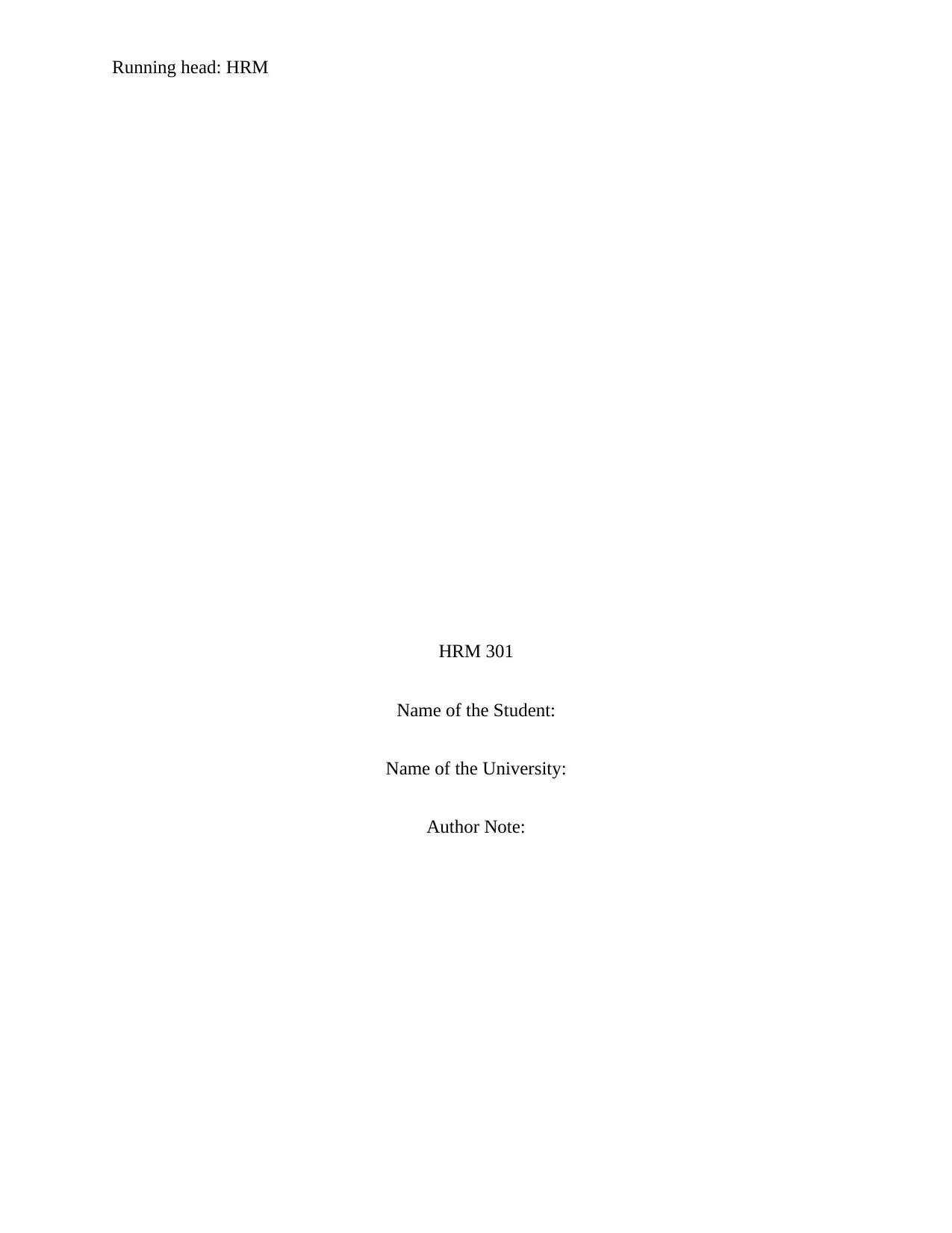
Running head: HRM
HRM 301
Name of the Student:
Name of the University:
Author Note:
HRM 301
Name of the Student:
Name of the University:
Author Note:
Paraphrase This Document
Need a fresh take? Get an instant paraphrase of this document with our AI Paraphraser
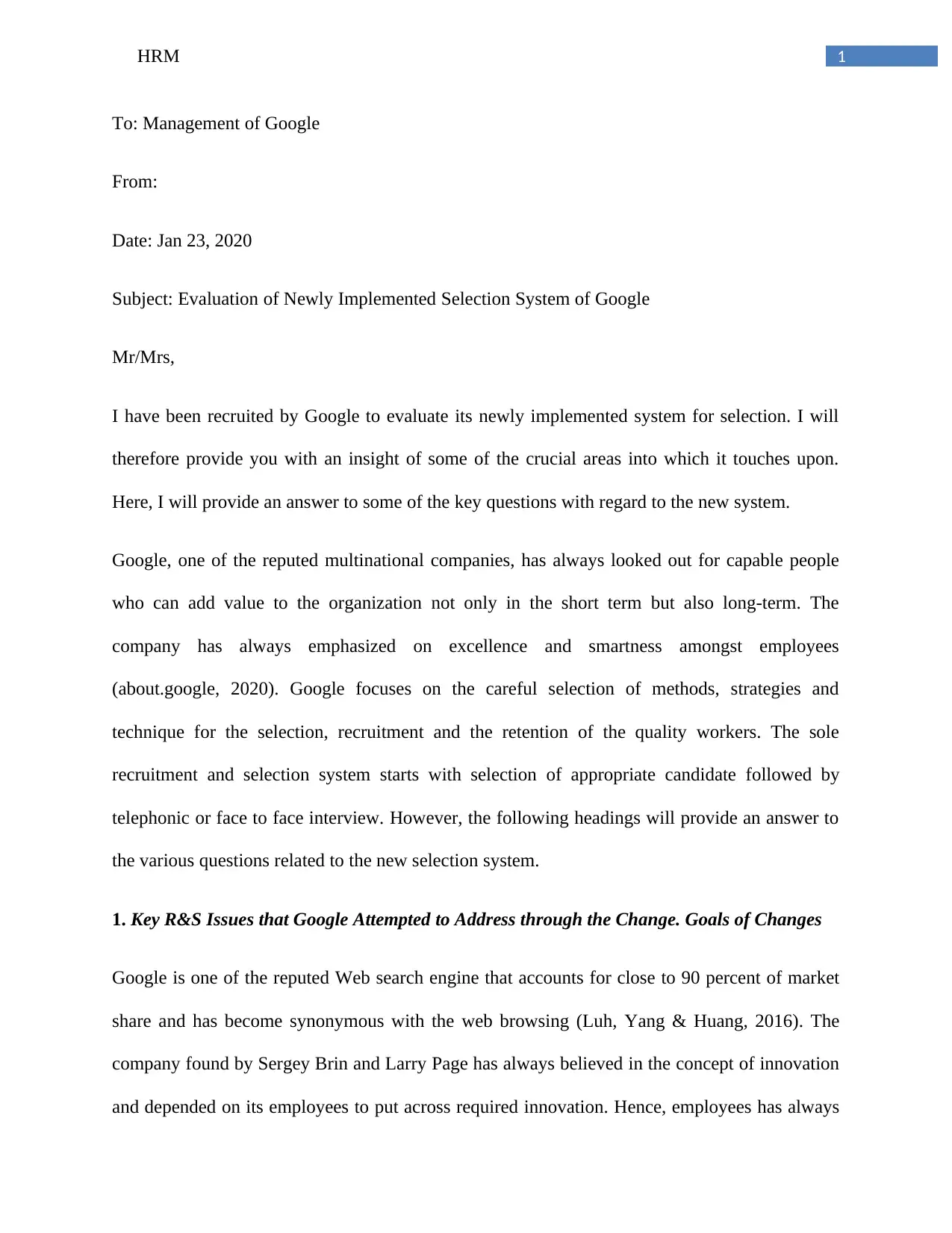
1HRM
To: Management of Google
From:
Date: Jan 23, 2020
Subject: Evaluation of Newly Implemented Selection System of Google
Mr/Mrs,
I have been recruited by Google to evaluate its newly implemented system for selection. I will
therefore provide you with an insight of some of the crucial areas into which it touches upon.
Here, I will provide an answer to some of the key questions with regard to the new system.
Google, one of the reputed multinational companies, has always looked out for capable people
who can add value to the organization not only in the short term but also long-term. The
company has always emphasized on excellence and smartness amongst employees
(about.google, 2020). Google focuses on the careful selection of methods, strategies and
technique for the selection, recruitment and the retention of the quality workers. The sole
recruitment and selection system starts with selection of appropriate candidate followed by
telephonic or face to face interview. However, the following headings will provide an answer to
the various questions related to the new selection system.
1. Key R&S Issues that Google Attempted to Address through the Change. Goals of Changes
Google is one of the reputed Web search engine that accounts for close to 90 percent of market
share and has become synonymous with the web browsing (Luh, Yang & Huang, 2016). The
company found by Sergey Brin and Larry Page has always believed in the concept of innovation
and depended on its employees to put across required innovation. Hence, employees has always
To: Management of Google
From:
Date: Jan 23, 2020
Subject: Evaluation of Newly Implemented Selection System of Google
Mr/Mrs,
I have been recruited by Google to evaluate its newly implemented system for selection. I will
therefore provide you with an insight of some of the crucial areas into which it touches upon.
Here, I will provide an answer to some of the key questions with regard to the new system.
Google, one of the reputed multinational companies, has always looked out for capable people
who can add value to the organization not only in the short term but also long-term. The
company has always emphasized on excellence and smartness amongst employees
(about.google, 2020). Google focuses on the careful selection of methods, strategies and
technique for the selection, recruitment and the retention of the quality workers. The sole
recruitment and selection system starts with selection of appropriate candidate followed by
telephonic or face to face interview. However, the following headings will provide an answer to
the various questions related to the new selection system.
1. Key R&S Issues that Google Attempted to Address through the Change. Goals of Changes
Google is one of the reputed Web search engine that accounts for close to 90 percent of market
share and has become synonymous with the web browsing (Luh, Yang & Huang, 2016). The
company found by Sergey Brin and Larry Page has always believed in the concept of innovation
and depended on its employees to put across required innovation. Hence, employees has always
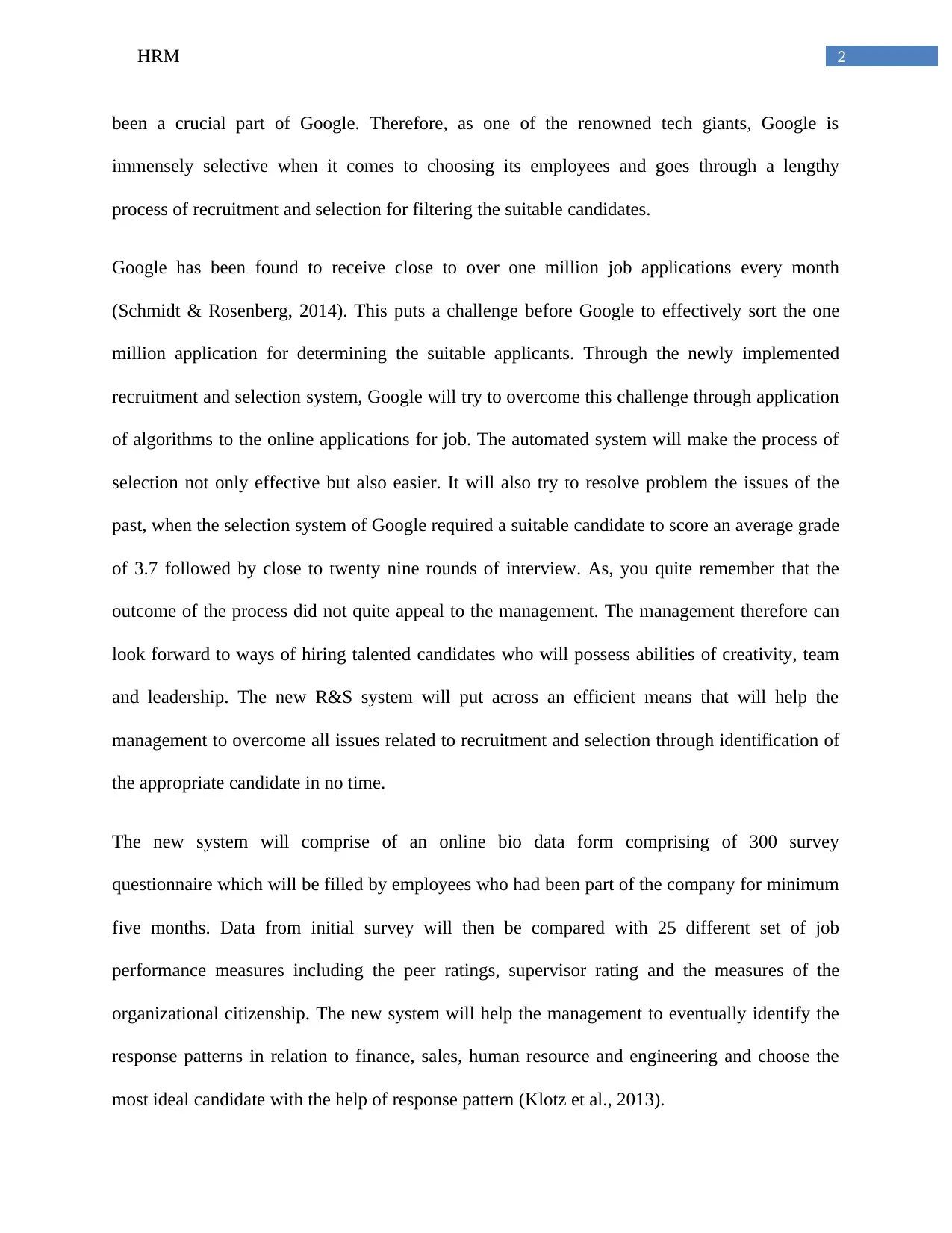
2HRM
been a crucial part of Google. Therefore, as one of the renowned tech giants, Google is
immensely selective when it comes to choosing its employees and goes through a lengthy
process of recruitment and selection for filtering the suitable candidates.
Google has been found to receive close to over one million job applications every month
(Schmidt & Rosenberg, 2014). This puts a challenge before Google to effectively sort the one
million application for determining the suitable applicants. Through the newly implemented
recruitment and selection system, Google will try to overcome this challenge through application
of algorithms to the online applications for job. The automated system will make the process of
selection not only effective but also easier. It will also try to resolve problem the issues of the
past, when the selection system of Google required a suitable candidate to score an average grade
of 3.7 followed by close to twenty nine rounds of interview. As, you quite remember that the
outcome of the process did not quite appeal to the management. The management therefore can
look forward to ways of hiring talented candidates who will possess abilities of creativity, team
and leadership. The new R&S system will put across an efficient means that will help the
management to overcome all issues related to recruitment and selection through identification of
the appropriate candidate in no time.
The new system will comprise of an online bio data form comprising of 300 survey
questionnaire which will be filled by employees who had been part of the company for minimum
five months. Data from initial survey will then be compared with 25 different set of job
performance measures including the peer ratings, supervisor rating and the measures of the
organizational citizenship. The new system will help the management to eventually identify the
response patterns in relation to finance, sales, human resource and engineering and choose the
most ideal candidate with the help of response pattern (Klotz et al., 2013).
been a crucial part of Google. Therefore, as one of the renowned tech giants, Google is
immensely selective when it comes to choosing its employees and goes through a lengthy
process of recruitment and selection for filtering the suitable candidates.
Google has been found to receive close to over one million job applications every month
(Schmidt & Rosenberg, 2014). This puts a challenge before Google to effectively sort the one
million application for determining the suitable applicants. Through the newly implemented
recruitment and selection system, Google will try to overcome this challenge through application
of algorithms to the online applications for job. The automated system will make the process of
selection not only effective but also easier. It will also try to resolve problem the issues of the
past, when the selection system of Google required a suitable candidate to score an average grade
of 3.7 followed by close to twenty nine rounds of interview. As, you quite remember that the
outcome of the process did not quite appeal to the management. The management therefore can
look forward to ways of hiring talented candidates who will possess abilities of creativity, team
and leadership. The new R&S system will put across an efficient means that will help the
management to overcome all issues related to recruitment and selection through identification of
the appropriate candidate in no time.
The new system will comprise of an online bio data form comprising of 300 survey
questionnaire which will be filled by employees who had been part of the company for minimum
five months. Data from initial survey will then be compared with 25 different set of job
performance measures including the peer ratings, supervisor rating and the measures of the
organizational citizenship. The new system will help the management to eventually identify the
response patterns in relation to finance, sales, human resource and engineering and choose the
most ideal candidate with the help of response pattern (Klotz et al., 2013).
⊘ This is a preview!⊘
Do you want full access?
Subscribe today to unlock all pages.

Trusted by 1+ million students worldwide
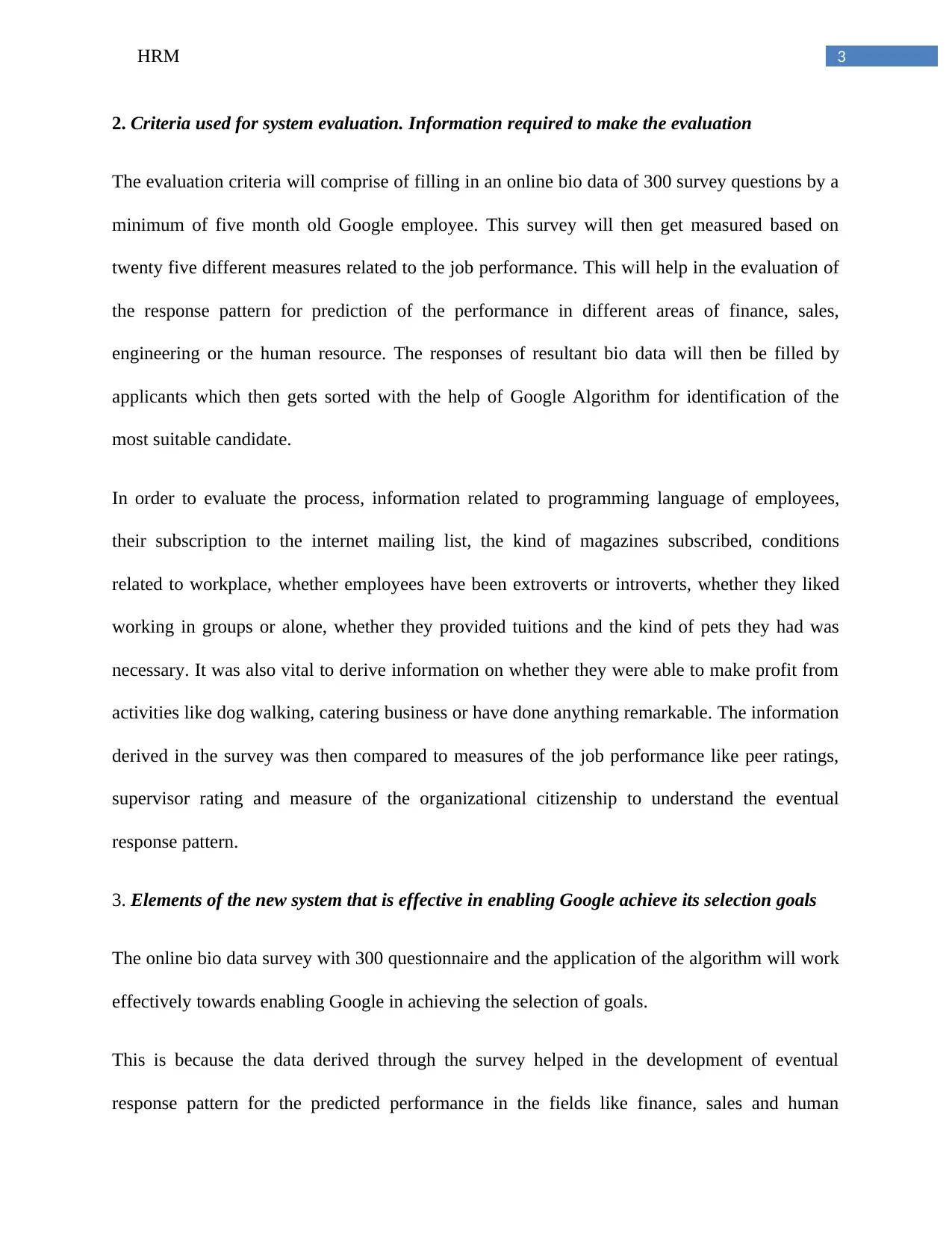
3HRM
2. Criteria used for system evaluation. Information required to make the evaluation
The evaluation criteria will comprise of filling in an online bio data of 300 survey questions by a
minimum of five month old Google employee. This survey will then get measured based on
twenty five different measures related to the job performance. This will help in the evaluation of
the response pattern for prediction of the performance in different areas of finance, sales,
engineering or the human resource. The responses of resultant bio data will then be filled by
applicants which then gets sorted with the help of Google Algorithm for identification of the
most suitable candidate.
In order to evaluate the process, information related to programming language of employees,
their subscription to the internet mailing list, the kind of magazines subscribed, conditions
related to workplace, whether employees have been extroverts or introverts, whether they liked
working in groups or alone, whether they provided tuitions and the kind of pets they had was
necessary. It was also vital to derive information on whether they were able to make profit from
activities like dog walking, catering business or have done anything remarkable. The information
derived in the survey was then compared to measures of the job performance like peer ratings,
supervisor rating and measure of the organizational citizenship to understand the eventual
response pattern.
3. Elements of the new system that is effective in enabling Google achieve its selection goals
The online bio data survey with 300 questionnaire and the application of the algorithm will work
effectively towards enabling Google in achieving the selection of goals.
This is because the data derived through the survey helped in the development of eventual
response pattern for the predicted performance in the fields like finance, sales and human
2. Criteria used for system evaluation. Information required to make the evaluation
The evaluation criteria will comprise of filling in an online bio data of 300 survey questions by a
minimum of five month old Google employee. This survey will then get measured based on
twenty five different measures related to the job performance. This will help in the evaluation of
the response pattern for prediction of the performance in different areas of finance, sales,
engineering or the human resource. The responses of resultant bio data will then be filled by
applicants which then gets sorted with the help of Google Algorithm for identification of the
most suitable candidate.
In order to evaluate the process, information related to programming language of employees,
their subscription to the internet mailing list, the kind of magazines subscribed, conditions
related to workplace, whether employees have been extroverts or introverts, whether they liked
working in groups or alone, whether they provided tuitions and the kind of pets they had was
necessary. It was also vital to derive information on whether they were able to make profit from
activities like dog walking, catering business or have done anything remarkable. The information
derived in the survey was then compared to measures of the job performance like peer ratings,
supervisor rating and measure of the organizational citizenship to understand the eventual
response pattern.
3. Elements of the new system that is effective in enabling Google achieve its selection goals
The online bio data survey with 300 questionnaire and the application of the algorithm will work
effectively towards enabling Google in achieving the selection of goals.
This is because the data derived through the survey helped in the development of eventual
response pattern for the predicted performance in the fields like finance, sales and human
Paraphrase This Document
Need a fresh take? Get an instant paraphrase of this document with our AI Paraphraser

4HRM
resource. Besides, the application of algorithm reduced the total number of interviews where
successful candidate participated. This is because, the new system with the help of its algorithm
will allow the management to identify the possible match who will then be contacted by the
recruiter for 30 to 40 minute screening interview over the phone. This will enable the recruiter in
making preliminary assessment and selecting the employee for face to face interview.
4. Elements of the system that requires additional refinement.
Mostly, I have found that surveys seem to be beneficial in defining the characteristics of a
larger population. There does not exist any other research method that is able to provide a
broader capability that ensure gathering of accurate samples for drawing in conclusions and
making vital decisions. There is however much apprehension about the reliability of the survey
data as the respondents might not have enough motivation for providing honest and accurate
answer (Chang & Vowles, 2013). The respondents who willingly chose to respond to the survey
question might be different from the ones who did not respond thus leading to a bias.
The survey can therefore be refined by shortening the questionnaire, sending notification through
email for notifying the employees about the survey, telling the respondents about its purpose and
the use of the feedback and being considerate about the time of respondent (Tiira & Loh, 2014).
5. Ethical, human rights or privacy concern of the new changes implemented.
Recommendations for addressing concerns.
The new system of online recruitment and selection can be ethically challenging due to
blurring of private and the public boundaries of the online spaces and the ease with which
sensitive data is hacked, shared, accessed and replicated (Gupta, 2017). An online survey carried
out for recruitment present exceptional ethical issues as it might pose a threat to ‘concern for
resource. Besides, the application of algorithm reduced the total number of interviews where
successful candidate participated. This is because, the new system with the help of its algorithm
will allow the management to identify the possible match who will then be contacted by the
recruiter for 30 to 40 minute screening interview over the phone. This will enable the recruiter in
making preliminary assessment and selecting the employee for face to face interview.
4. Elements of the system that requires additional refinement.
Mostly, I have found that surveys seem to be beneficial in defining the characteristics of a
larger population. There does not exist any other research method that is able to provide a
broader capability that ensure gathering of accurate samples for drawing in conclusions and
making vital decisions. There is however much apprehension about the reliability of the survey
data as the respondents might not have enough motivation for providing honest and accurate
answer (Chang & Vowles, 2013). The respondents who willingly chose to respond to the survey
question might be different from the ones who did not respond thus leading to a bias.
The survey can therefore be refined by shortening the questionnaire, sending notification through
email for notifying the employees about the survey, telling the respondents about its purpose and
the use of the feedback and being considerate about the time of respondent (Tiira & Loh, 2014).
5. Ethical, human rights or privacy concern of the new changes implemented.
Recommendations for addressing concerns.
The new system of online recruitment and selection can be ethically challenging due to
blurring of private and the public boundaries of the online spaces and the ease with which
sensitive data is hacked, shared, accessed and replicated (Gupta, 2017). An online survey carried
out for recruitment present exceptional ethical issues as it might pose a threat to ‘concern for
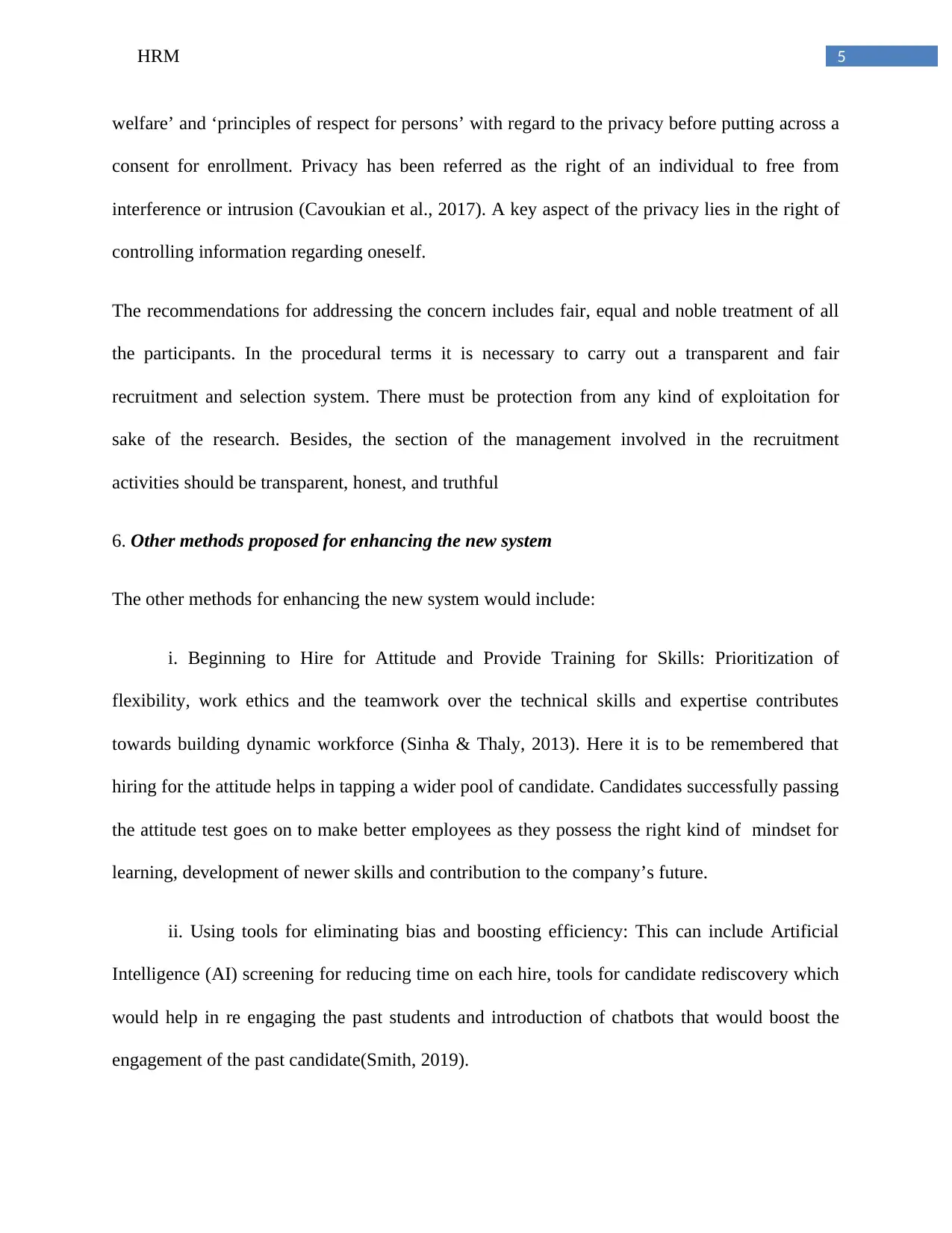
5HRM
welfare’ and ‘principles of respect for persons’ with regard to the privacy before putting across a
consent for enrollment. Privacy has been referred as the right of an individual to free from
interference or intrusion (Cavoukian et al., 2017). A key aspect of the privacy lies in the right of
controlling information regarding oneself.
The recommendations for addressing the concern includes fair, equal and noble treatment of all
the participants. In the procedural terms it is necessary to carry out a transparent and fair
recruitment and selection system. There must be protection from any kind of exploitation for
sake of the research. Besides, the section of the management involved in the recruitment
activities should be transparent, honest, and truthful
6. Other methods proposed for enhancing the new system
The other methods for enhancing the new system would include:
i. Beginning to Hire for Attitude and Provide Training for Skills: Prioritization of
flexibility, work ethics and the teamwork over the technical skills and expertise contributes
towards building dynamic workforce (Sinha & Thaly, 2013). Here it is to be remembered that
hiring for the attitude helps in tapping a wider pool of candidate. Candidates successfully passing
the attitude test goes on to make better employees as they possess the right kind of mindset for
learning, development of newer skills and contribution to the company’s future.
ii. Using tools for eliminating bias and boosting efficiency: This can include Artificial
Intelligence (AI) screening for reducing time on each hire, tools for candidate rediscovery which
would help in re engaging the past students and introduction of chatbots that would boost the
engagement of the past candidate(Smith, 2019).
welfare’ and ‘principles of respect for persons’ with regard to the privacy before putting across a
consent for enrollment. Privacy has been referred as the right of an individual to free from
interference or intrusion (Cavoukian et al., 2017). A key aspect of the privacy lies in the right of
controlling information regarding oneself.
The recommendations for addressing the concern includes fair, equal and noble treatment of all
the participants. In the procedural terms it is necessary to carry out a transparent and fair
recruitment and selection system. There must be protection from any kind of exploitation for
sake of the research. Besides, the section of the management involved in the recruitment
activities should be transparent, honest, and truthful
6. Other methods proposed for enhancing the new system
The other methods for enhancing the new system would include:
i. Beginning to Hire for Attitude and Provide Training for Skills: Prioritization of
flexibility, work ethics and the teamwork over the technical skills and expertise contributes
towards building dynamic workforce (Sinha & Thaly, 2013). Here it is to be remembered that
hiring for the attitude helps in tapping a wider pool of candidate. Candidates successfully passing
the attitude test goes on to make better employees as they possess the right kind of mindset for
learning, development of newer skills and contribution to the company’s future.
ii. Using tools for eliminating bias and boosting efficiency: This can include Artificial
Intelligence (AI) screening for reducing time on each hire, tools for candidate rediscovery which
would help in re engaging the past students and introduction of chatbots that would boost the
engagement of the past candidate(Smith, 2019).
⊘ This is a preview!⊘
Do you want full access?
Subscribe today to unlock all pages.

Trusted by 1+ million students worldwide
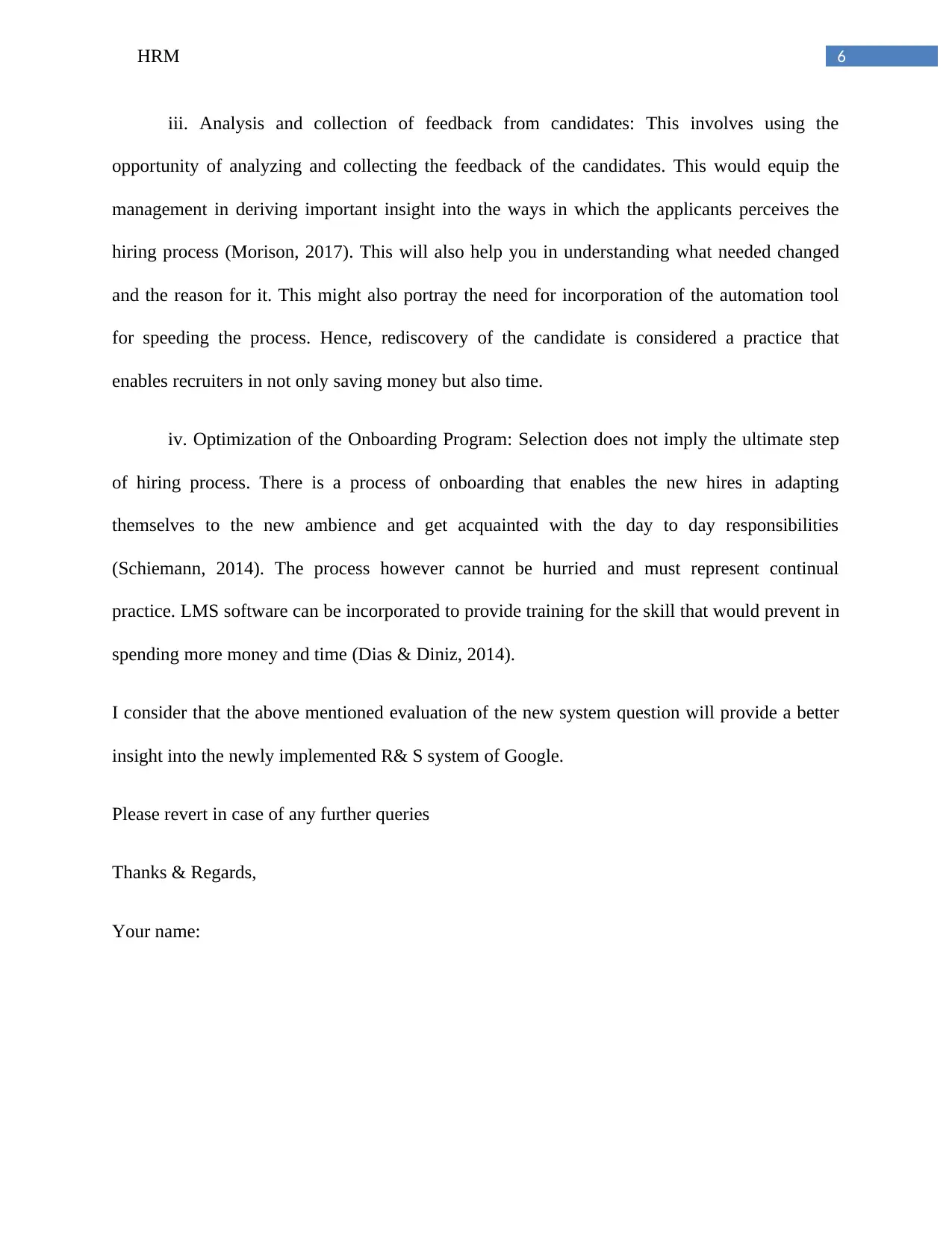
6HRM
iii. Analysis and collection of feedback from candidates: This involves using the
opportunity of analyzing and collecting the feedback of the candidates. This would equip the
management in deriving important insight into the ways in which the applicants perceives the
hiring process (Morison, 2017). This will also help you in understanding what needed changed
and the reason for it. This might also portray the need for incorporation of the automation tool
for speeding the process. Hence, rediscovery of the candidate is considered a practice that
enables recruiters in not only saving money but also time.
iv. Optimization of the Onboarding Program: Selection does not imply the ultimate step
of hiring process. There is a process of onboarding that enables the new hires in adapting
themselves to the new ambience and get acquainted with the day to day responsibilities
(Schiemann, 2014). The process however cannot be hurried and must represent continual
practice. LMS software can be incorporated to provide training for the skill that would prevent in
spending more money and time (Dias & Diniz, 2014).
I consider that the above mentioned evaluation of the new system question will provide a better
insight into the newly implemented R& S system of Google.
Please revert in case of any further queries
Thanks & Regards,
Your name:
iii. Analysis and collection of feedback from candidates: This involves using the
opportunity of analyzing and collecting the feedback of the candidates. This would equip the
management in deriving important insight into the ways in which the applicants perceives the
hiring process (Morison, 2017). This will also help you in understanding what needed changed
and the reason for it. This might also portray the need for incorporation of the automation tool
for speeding the process. Hence, rediscovery of the candidate is considered a practice that
enables recruiters in not only saving money but also time.
iv. Optimization of the Onboarding Program: Selection does not imply the ultimate step
of hiring process. There is a process of onboarding that enables the new hires in adapting
themselves to the new ambience and get acquainted with the day to day responsibilities
(Schiemann, 2014). The process however cannot be hurried and must represent continual
practice. LMS software can be incorporated to provide training for the skill that would prevent in
spending more money and time (Dias & Diniz, 2014).
I consider that the above mentioned evaluation of the new system question will provide a better
insight into the newly implemented R& S system of Google.
Please revert in case of any further queries
Thanks & Regards,
Your name:
Paraphrase This Document
Need a fresh take? Get an instant paraphrase of this document with our AI Paraphraser
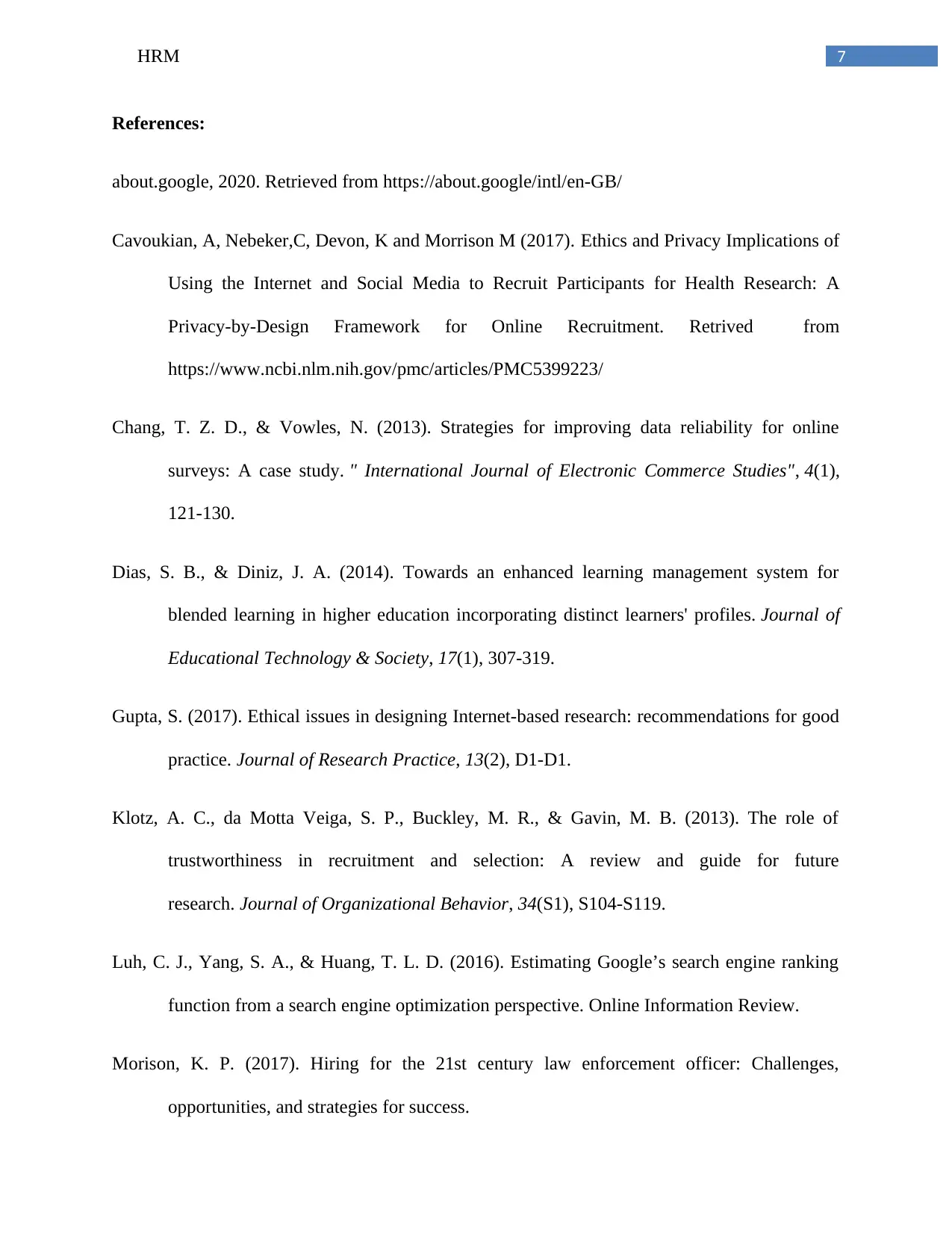
7HRM
References:
about.google, 2020. Retrieved from https://about.google/intl/en-GB/
Cavoukian, A, Nebeker,C, Devon, K and Morrison M (2017). Ethics and Privacy Implications of
Using the Internet and Social Media to Recruit Participants for Health Research: A
Privacy-by-Design Framework for Online Recruitment. Retrived from
https://www.ncbi.nlm.nih.gov/pmc/articles/PMC5399223/
Chang, T. Z. D., & Vowles, N. (2013). Strategies for improving data reliability for online
surveys: A case study. " International Journal of Electronic Commerce Studies", 4(1),
121-130.
Dias, S. B., & Diniz, J. A. (2014). Towards an enhanced learning management system for
blended learning in higher education incorporating distinct learners' profiles. Journal of
Educational Technology & Society, 17(1), 307-319.
Gupta, S. (2017). Ethical issues in designing Internet-based research: recommendations for good
practice. Journal of Research Practice, 13(2), D1-D1.
Klotz, A. C., da Motta Veiga, S. P., Buckley, M. R., & Gavin, M. B. (2013). The role of
trustworthiness in recruitment and selection: A review and guide for future
research. Journal of Organizational Behavior, 34(S1), S104-S119.
Luh, C. J., Yang, S. A., & Huang, T. L. D. (2016). Estimating Google’s search engine ranking
function from a search engine optimization perspective. Online Information Review.
Morison, K. P. (2017). Hiring for the 21st century law enforcement officer: Challenges,
opportunities, and strategies for success.
References:
about.google, 2020. Retrieved from https://about.google/intl/en-GB/
Cavoukian, A, Nebeker,C, Devon, K and Morrison M (2017). Ethics and Privacy Implications of
Using the Internet and Social Media to Recruit Participants for Health Research: A
Privacy-by-Design Framework for Online Recruitment. Retrived from
https://www.ncbi.nlm.nih.gov/pmc/articles/PMC5399223/
Chang, T. Z. D., & Vowles, N. (2013). Strategies for improving data reliability for online
surveys: A case study. " International Journal of Electronic Commerce Studies", 4(1),
121-130.
Dias, S. B., & Diniz, J. A. (2014). Towards an enhanced learning management system for
blended learning in higher education incorporating distinct learners' profiles. Journal of
Educational Technology & Society, 17(1), 307-319.
Gupta, S. (2017). Ethical issues in designing Internet-based research: recommendations for good
practice. Journal of Research Practice, 13(2), D1-D1.
Klotz, A. C., da Motta Veiga, S. P., Buckley, M. R., & Gavin, M. B. (2013). The role of
trustworthiness in recruitment and selection: A review and guide for future
research. Journal of Organizational Behavior, 34(S1), S104-S119.
Luh, C. J., Yang, S. A., & Huang, T. L. D. (2016). Estimating Google’s search engine ranking
function from a search engine optimization perspective. Online Information Review.
Morison, K. P. (2017). Hiring for the 21st century law enforcement officer: Challenges,
opportunities, and strategies for success.
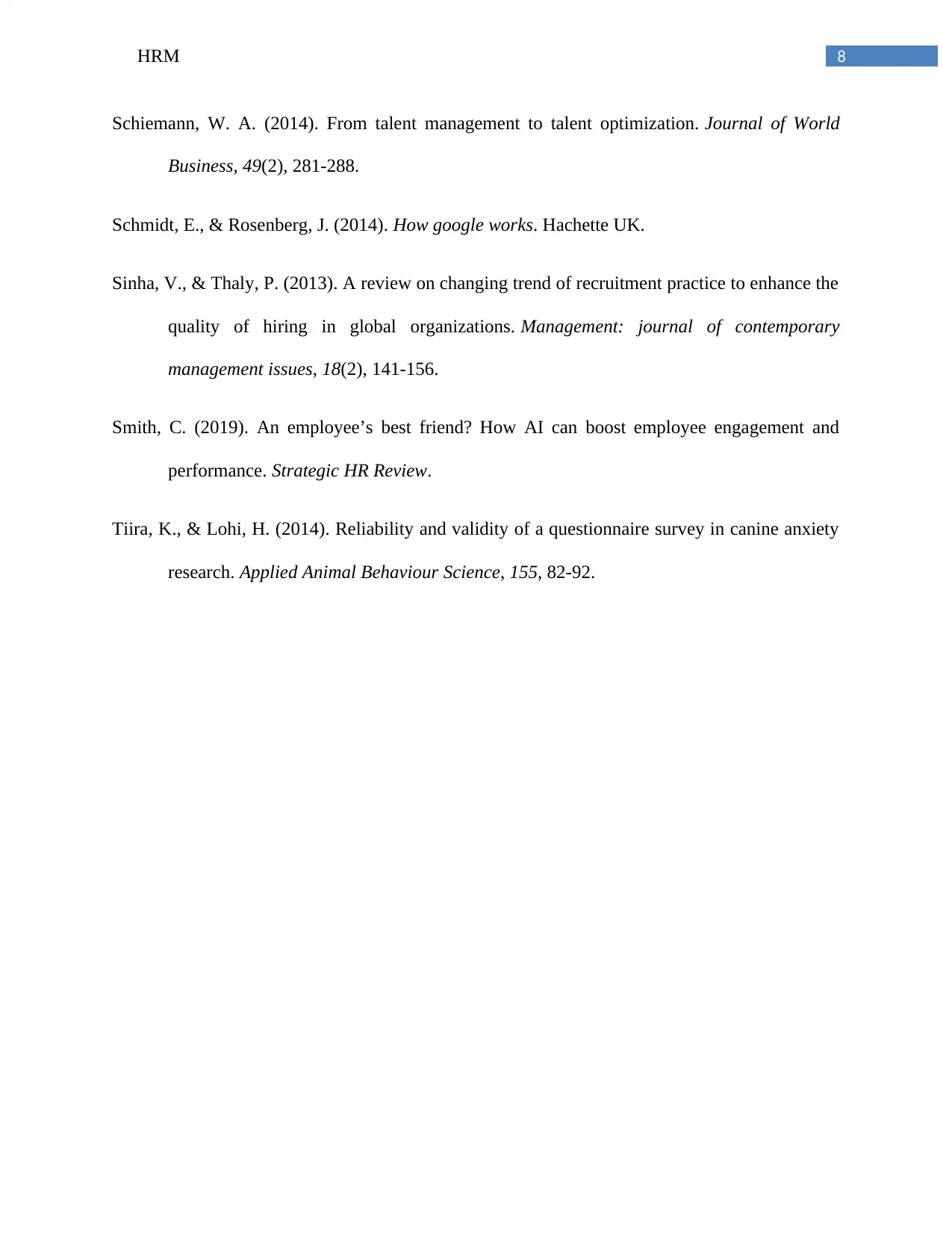
8HRM
Schiemann, W. A. (2014). From talent management to talent optimization. Journal of World
Business, 49(2), 281-288.
Schmidt, E., & Rosenberg, J. (2014). How google works. Hachette UK.
Sinha, V., & Thaly, P. (2013). A review on changing trend of recruitment practice to enhance the
quality of hiring in global organizations. Management: journal of contemporary
management issues, 18(2), 141-156.
Smith, C. (2019). An employee’s best friend? How AI can boost employee engagement and
performance. Strategic HR Review.
Tiira, K., & Lohi, H. (2014). Reliability and validity of a questionnaire survey in canine anxiety
research. Applied Animal Behaviour Science, 155, 82-92.
Schiemann, W. A. (2014). From talent management to talent optimization. Journal of World
Business, 49(2), 281-288.
Schmidt, E., & Rosenberg, J. (2014). How google works. Hachette UK.
Sinha, V., & Thaly, P. (2013). A review on changing trend of recruitment practice to enhance the
quality of hiring in global organizations. Management: journal of contemporary
management issues, 18(2), 141-156.
Smith, C. (2019). An employee’s best friend? How AI can boost employee engagement and
performance. Strategic HR Review.
Tiira, K., & Lohi, H. (2014). Reliability and validity of a questionnaire survey in canine anxiety
research. Applied Animal Behaviour Science, 155, 82-92.
⊘ This is a preview!⊘
Do you want full access?
Subscribe today to unlock all pages.

Trusted by 1+ million students worldwide
1 out of 9
Related Documents
Your All-in-One AI-Powered Toolkit for Academic Success.
+13062052269
info@desklib.com
Available 24*7 on WhatsApp / Email
![[object Object]](/_next/static/media/star-bottom.7253800d.svg)
Unlock your academic potential
Copyright © 2020–2025 A2Z Services. All Rights Reserved. Developed and managed by ZUCOL.





